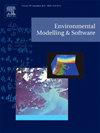基于机器学习的地下生物量从地上生物量和土壤性质预测
IF 4.8
2区 环境科学与生态学
Q1 COMPUTER SCIENCE, INTERDISCIPLINARY APPLICATIONS
引用次数: 0
摘要
地下生物量(BGB)的精确定量对理解陆地碳动态至关重要。传统的BGB估算方法存在许多缺点,包括无法解决植物物种之间的差异,高度依赖于胸围直径,以及破坏性采样。为了解决这些问题,我们开发了一个新的机器学习框架,通过整合中国黄土高原294个样地的植被和土壤数据来估计草地BGB。结合XGBoost回归、Gradient boosting回归、Ridge回归和ElasticNet回归的集成模型优于单个模型,训练R2为0.623,测试R2为0.502,突出了其识别BGB复杂依赖关系的卓越能力。整合土壤有机碳、植物高度和地上生物量等关键特征显著提高了预测精度。在传统模型中,bgb环境的非线性相互作用通常被低估。本文提出的模型提高了我们评估地下碳储量的能力,并为了解竞争光照条件下草地物种的生态策略提供了见解。通过揭示土壤和植被对BGB的多方面影响,我们的研究完善了对草地碳动态的认识。这项研究标志着在生态建模中利用先进的机器学习来促进更准确地预测全球变化的先例。本文章由计算机程序翻译,如有差异,请以英文原文为准。
Machine learning-based prediction of belowground biomass from aboveground biomass and soil properties
Precise and accurate quantification of belowground biomass (BGB) is essential for understanding terrestrial carbon dynamics. Traditional methods for estimating BGB suffer from a number of disadvantages, including inability to resolve differences among plant species, high dependence on Diameter at Breast Height, and destructive sampling. To address these issues, we developed a novel machine learning framework to estimate grassland BGB by integrating vegetation and soil data from 294 plots on China's Loess Plateau. An ensemble model combining XGBoost regression, Gradient boosting regression, Ridge regression, and ElasticNet regression outperformed the individual models, achieving a training R2 of 0.623 and a testing R2 of 0.502, highlighting its superior ability to identify the complex dependencies of BGB. Integration of key features, including soil organic carbon, plant height, and aboveground biomass, significantly improved the predictive accuracy. Nonlinear BGB–environment interactions are commonly underrecognized in traditional models. The model presented herein advances our ability to assess underground carbon stocks and offers insights into the ecological strategies of grassland species under competitive light conditions. By revealing the multifaceted influences of soil and vegetation on BGB, our research refines the understanding of grassland carbon dynamics. This study marks a precedent for harnessing advanced machine learning in ecological modeling to facilitate more accurate predictions of global change.
求助全文
通过发布文献求助,成功后即可免费获取论文全文。
去求助
来源期刊

Environmental Modelling & Software
工程技术-工程:环境
CiteScore
9.30
自引率
8.20%
发文量
241
审稿时长
60 days
期刊介绍:
Environmental Modelling & Software publishes contributions, in the form of research articles, reviews and short communications, on recent advances in environmental modelling and/or software. The aim is to improve our capacity to represent, understand, predict or manage the behaviour of environmental systems at all practical scales, and to communicate those improvements to a wide scientific and professional audience.
 求助内容:
求助内容: 应助结果提醒方式:
应助结果提醒方式:


